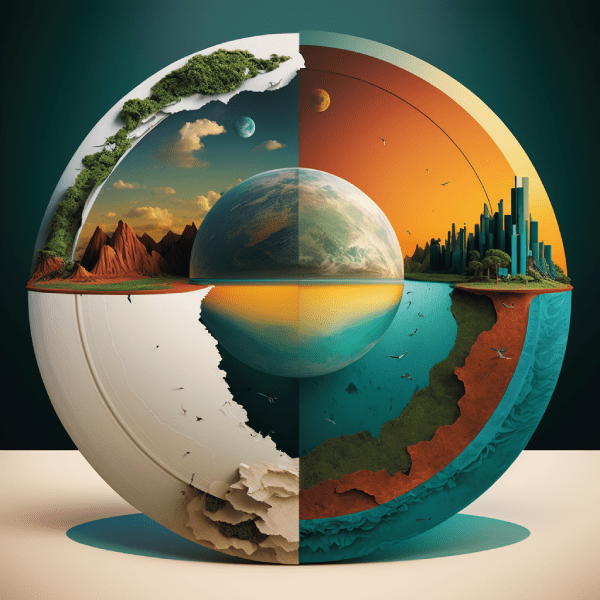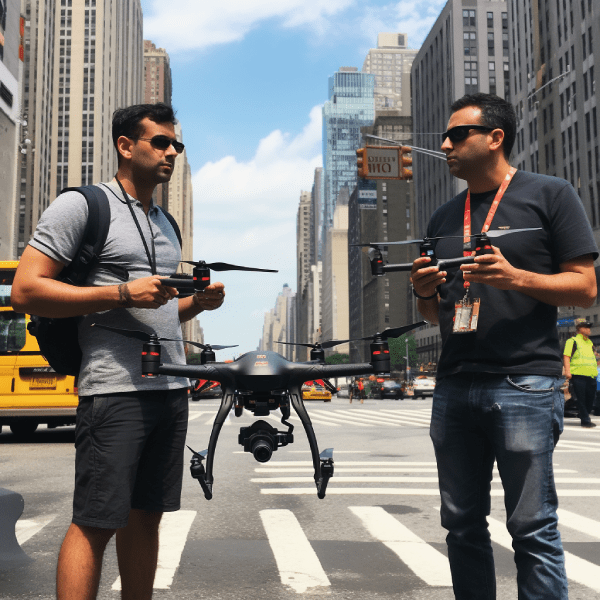Introduction
The United Nations Sustainable Development Goals (UN SDGs) are a set of 17 goals aimed at promoting sustainable development worldwide. These goals address a wide range of issues, including poverty, hunger, health, education, gender equality, clean water and sanitation, affordable and clean energy, and climate action. Achieving these goals is crucial for ensuring a sustainable future for our planet.
In this blog post, we will explore how AI and blockchain technology can be utilized to push businesses towards achieving these goals.
Artificial Intelligence and UN SDGs
Artificial Intelligence (AI) can assist businesses in several ways to achieve UN SDGs. Firstly, AI can assist in the identification of areas where sustainable practices can be implemented. For example, AI can be utilized to analyze data from various sources, including social media, news articles, and sensor data, to identify areas where sustainable practices can be implemented. This can provide businesses with valuable insights into areas that need improvement.
Secondly, AI can assist in the optimization of resource usage. AI can analyze data from various sources, including energy usage, water usage, and waste generation, to provide recommendations for optimizing resource usage. This can help businesses reduce their environmental impact and improve their sustainability performance.
Thirdly, AI can assist in the development of sustainable products. AI can analyze customer data to identify trends in product demand and assist businesses in developing products that are sustainable and appeal to environmentally conscious consumers.
Fourthly, AI can assist in the implementation of sustainable practices in the supply chain. AI can be utilized to track and analyze the sustainability performance of suppliers and assist businesses in selecting suppliers that meet sustainability criteria.
Blockchain technology and UN SDGs
Blockchain technology can be utilized to track and trace the supply chain of products. This can help businesses identify areas where sustainable practices can be implemented and provide consumers with transparency into the production process.
Blockchain technology can also assist in the verification of sustainability claims. Blockchain technology can be utilized to verify the sustainability of raw materials and products, which can help businesses make more informed decisions about their sustainability performance.
Moreover, blockchain technology can assist in the development of sustainable supply chains. Blockchain technology can be utilized to incentivize suppliers to adopt sustainable practices by providing rewards for sustainable behavior.
Blockchain technology can also assist in the development of sustainable finance. Sustainable finance refers to the integration of environmental, social, and governance (ESG) factors into financial decision-making. This includes the development of financial products and services that support sustainable development and the achievement of UN SDGs.
Here are some ways in which blockchain technology can be utilized to develop sustainable finance products:
- Transparency: Blockchain technology can provide transparency and traceability in financial transactions. This can enable investors to track the use of funds and ensure that they are being utilized for sustainable purposes. By providing transparency, blockchain technology can help build trust and confidence in sustainable finance products.
- Accountability: Blockchain technology can enable smart contracts, which can automate the enforcement of sustainability criteria. For example, smart contracts can ensure that funds are only released when specific sustainability targets are met. This can help ensure that sustainable finance products are being used to support sustainable development.
- Efficiency: Blockchain technology can streamline the issuance and management of sustainable finance products. This can reduce costs and increase accessibility, making sustainable finance products more widely available to investors.
- Green bonds: Blockchain technology can be utilized to develop green bonds, which are bonds issued to finance environmentally sustainable projects. Blockchain technology can provide transparency and traceability in the use of funds, ensuring that they are being utilized for sustainable purposes. This can help build trust and confidence in green bonds and attract more investors to support sustainable development.
- Sustainability-linked loans: Blockchain technology can be utilized to develop sustainability-linked loans, which are loans that offer lower interest rates to borrowers who meet sustainability criteria. Blockchain technology can provide transparency and accountability in the verification of sustainability criteria, ensuring that borrowers are meeting their sustainability targets. This can help incentivize sustainable behavior and support the achievement of UN SDGs.
Conclusion
In conclusion, the integration of AI and blockchain technology can play a significant role in helping businesses achieve UN SDGs. These technologies can assist in the identification of sustainable practices, the optimization of resource usage, the development of sustainable products, and the implementation of sustainable practices in the supply chain.
Blockchain technology can assist in the verification of sustainability claims, the development of sustainable supply chains, and the development of sustainable finance. Therefore, businesses must explore the use of AI and blockchain technology to promote sustainable practices in their operations and contribute to the achievement of UN SDGs.
Real-life examples of AI and blockchain technology applications in achieving SDGs
- AI for sustainable agriculture: Agrosmart, a Brazilian agritech company, has developed an AI-based platform to help farmers optimize crop yields and reduce water usage. The platform analyzes data from weather sensors, soil moisture sensors, and satellite imagery to provide recommendations for irrigation and crop management. This can help farmers reduce water usage by up to 50% and increase crop yields by up to 30%. By promoting sustainable agriculture, Agrosmart is contributing to SDG 2: Zero Hunger and SDG 6: Clean Water and Sanitation.
- AI for sustainable mobility: Uber has implemented AI to optimize its ride-sharing service and reduce congestion in urban areas. The AI algorithms analyze traffic patterns and rider demand to optimize driver routes and reduce idle time. Additionally, Uber has launched several electric and hybrid vehicle programs to reduce emissions and promote sustainable transportation. By promoting sustainable mobility, Uber is contributing to SDG 11: Sustainable Cities and Communities.
- AI for sustainable tourism: Booking.com, a global online travel company, has implemented AI to promote sustainable tourism practices. The AI algorithms analyze user data to provide recommendations for sustainable travel options, such as eco-friendly accommodations and low-emission transportation options. Additionally, Booking.com has launched a sustainability-focused certification program for accommodations, providing consumers with transparency into their sustainability performance. By promoting sustainable tourism practices, Booking.com is contributing to SDG 14: Life Below Water and SDG 15: Life on Land.
- AI for sustainable fisheries: Pelagic Data Systems, a California-based technology company, has developed an AI-based platform to promote sustainable fishing practices. The platform uses satellite technology and AI algorithms to track fishing vessels and monitor their fishing activity. This can help prevent overfishing and promote sustainable fishing practices, contributing to SDG 14: Life Below Water.
- Blockchain for sustainable energy: Power Ledger, an Australian energy trading company, has implemented blockchain technology to promote renewable energy trading. The technology enables consumers to trade excess renewable energy with each other, incentivizing the use of renewable energy and reducing carbon emissions. Additionally, Power Ledger has partnered with several energy companies to launch renewable energy trading pilot projects. By promoting renewable energy trading, Power Ledger is contributing to SDG 7: Affordable and Clean Energy.
- Blockchain for sustainable microfinance: Humaniq, a blockchain-based fintech company, has developed a mobile banking platform to provide financial services to the unbanked population in developing countries. The platform utilizes blockchain technology to provide secure and transparent financial transactions, reducing the risk of fraud and corruption. Additionally, Humaniq has launched several microfinance initiatives, providing small loans to individuals and small businesses in developing countries. By promoting sustainable microfinance practices, Humaniq is contributing to SDG 1: No Poverty and SDG 8: Decent Work and Economic Growth.
- Blockchain for sustainable remittances: BitPesa, a blockchain-based remittance company, has implemented blockchain technology to enable cross-border remittances with reduced fees and faster transaction times. The technology utilizes cryptocurrency and blockchain to provide secure and transparent transactions. Additionally, BitPesa has launched several initiatives to promote financial inclusion and improve access to financial services in Africa. By promoting sustainable remittances and financial inclusion, BitPesa is contributing to SDG 1: No Poverty and SDG 8: Decent Work and Economic Growth.
- Blockchain for sustainable philanthropy: The UN World Food Programme (WFP) has implemented blockchain technology to provide transparency and traceability in its philanthropic donations. The technology enables donors to track the journey of their donations and ensure that they are being utilized for sustainable purposes. Additionally, the WFP has launched several pilot projects, such as a refugee food voucher program in Jordan, to promote sustainable food systems and reduce hunger. By promoting sustainable philanthropy and food systems, the WFP is contributing to SDG 2: Zero Hunger.
- Blockchain for sustainable real estate: Harbor, a blockchain-based real estate platform, has implemented blockchain technology to enable tokenization of real estate assets. The technology enables investors to purchase fractional ownership of real estate assets, promoting liquidity and reducing barriers to entry. Additionally, Harbor has launched several sustainability-focused real estate projects, such as a solar-powered affordable housing project in Los Angeles. By promoting sustainable real estate practices and affordable housing, Harbor is contributing to SDG 11: Sustainable Cities and Communities.
- AI for sustainable microcredit: Kiva, a microcredit platform, has implemented AI to improve its microcredit lending practices. The AI algorithms analyze customer data to assess creditworthiness and provide recommendations for sustainable microcredit products, such as loans for renewable energy projects. Additionally, Kiva has launched several sustainability-focused initiatives, such as its green loan program, to promote sustainable finance and reduce poverty. By promoting sustainable microcredit lending practices and sustainable finance, Kiva is contributing to SDG 1: No Poverty and SDG 7: Affordable and Clean Energy.
Overall, AI and blockchain technology offer a range of opportunities for businesses to contribute to sustainable development and achieve the UN SDGs. By leveraging these technologies, businesses can promote financial inclusion, reduce poverty, promote sustainable agriculture, and contribute to a sustainable future for all.



